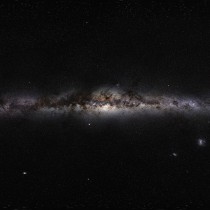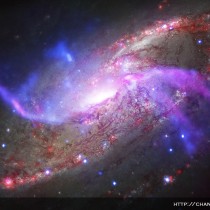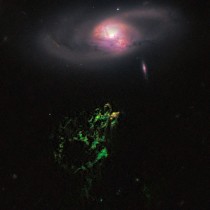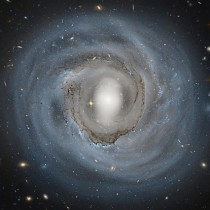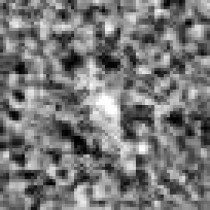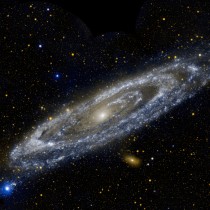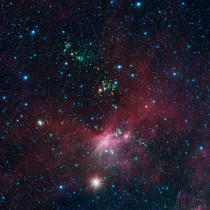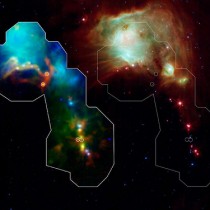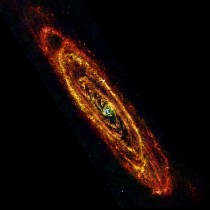How Many Stars in the Milky Way?
- By Maggie Masetti
- July 22, 2015
- Comments Off on How Many Stars in the Milky Way?
Recently I was asked to help someone answer the question of how many stars are in the Milky Way – that there were differing answers out there, and which was the right one? This question turns out to have a really interesting (and possibly frustrating?) answer. And the answer is … Continue Reading →
The Most Important Wavelength
- By Maggie Masetti
- June 22, 2015
- Comments Off on The Most Important Wavelength
I was recently asked whether optical telescopes were the most important kind – or if they weren’t – what the most important wavelength of light was. The answer truly is – they are all important! Most astronomical objects and phenomena emit light at more than one wavelength – so if … Continue Reading →
More “Voorwerps”?
- By Maggie Masetti
- April 16, 2015
- Comments Off on More “Voorwerps”?
Back in 2010, Koji wrote a guest blog for us on Hanny’s Voorwerp. What is this? Back in 2007, a Dutch woman named Hanny van Arkel discovered an odd and until then unclassified ghostly gaseous structure near the galaxy IC 2497 while using the citizen science site, Galaxy Zoo. The … Continue Reading →
Galaxy Face-off
- By Maggie Masetti
- January 2, 2014
- Comments Off on Galaxy Face-off
I recently stumbled across this gorgeous image of NGC 4921, so I thought perhaps a post showing a selection of gorgeous face-on galaxies would be in order. First up, the aforementioned barred spiral, NGC 4921. Note its bright nucleus, the bright central bar, and the ring of dark dust. Outside … Continue Reading →
Why infrared? (earliest galaxies edition)
- By Maggie Masetti
- September 12, 2013
- Comments Off on Why infrared? (earliest galaxies edition)
This is the second blog in a series which asks the question, why infrared? Last time we looked at how infrared light could reveal baby stars hidden from visible-light observatories by opaque clouds of gas. In this blog I’m going to talk about (what else?) the James Webb Space Telescope … Continue Reading →
Celebrating GALEX
- By Maggie Masetti
- August 2, 2013
- 1 Comment
We recently said a fond farewell to the Galaxy Evolution Explorer (GALEX) mission, which was decommissioned in June. GALEX had a single instrument onboard that was both an imager and a spectrometer at UV wavelengths. It was launched in April of 2003, and spent 10 years studying hundreds of millions … Continue Reading →
American Astronomical Society wrap-up
- By Jason McCracken
- June 14, 2013
- Comments Off on American Astronomical Society wrap-up
Well, it happened again, guys! The 222nd biannual meeting of the American Astronomical Society (AAS) held at the Indiana Convention Center, that’s what. For those of you not in the loop, the American Astronomical Society is a professional society for astronomers devoted to promoting astronomy and like sciences as well … Continue Reading →
Come Together
- By Maggie Masetti
- April 9, 2013
- 2 Comments
If you’re at all a fan of astronomy, you’ve probably marveled over the many beautiful photos of spiral galaxies that are out there. Like this one of NGC 3344 captured by the Hubble Space Telescope. Credit: ESA/Hubble & NASABut you may not know that galaxies have not always looked this … Continue Reading →
Awww! Cosmic baby pictures!
- By Sara Mitchell
- March 22, 2013
- Comments Off on Awww! Cosmic baby pictures!
Protostars in Messier 78, as seen by multiple observatories Credit: NASA/ESA/ESO/JPL-Caltech/Max-Planck The side-by-side images above depict protostars found in Messier 78, a reflection nebula found within the constellation Orion (but not the Orion Nebula, which is Messier 42). These are some of the youngest stars that astronomers have ever seen … Continue Reading →
Andromeda in the Infrared
- By Maggie Masetti
- February 11, 2013
- Comments Off on Andromeda in the Infrared
Check out this gorgeous new image of the Andromeda Galaxy taken by the European Space Agency’s Herschel space observatory in the far-infrared. This new view shows cool lanes of forming stars in fine detail. Credit: ESA The news release says, Sensitive to the far-infrared light from cool dust mixed in … Continue Reading →


